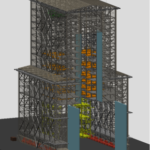The first structural element of the mobile gantry that will house and protect Ariane 6 before launch has been assembled.
The mobile gantry is a 90 m-high, nine-storey structure weighing 8200 tonnes. Riding on rails, it is retracted before launch.
Work platforms will enable engineers to access the vehicle levels to vertically position Ariane 6’s central core directly on the launch table, add two or four boosters depending on the launch configuration, and integrate the fairing that houses the payload.
A mobile gantry gives engineers better access to the launcher, allowing them to make adjustments without moving the rocket back to the assembly building – unlike Ariane 5, which is moved on a table to the pad on launch day.
Assembly of the gantry started on 15 November and will take 10 months. The ground floor will be completed by the end of this year.
Other developments at the Spaceport include the construction of the Launcher Assembly Building. The structure is 20 m tall, 112 m long and 41 m wide, some 1 km from the launch zone.
Here, Ariane 6’s central core is horizontally assembled and prepared for rollout to the launch zone. Building started in August and cladding is now being added to the walls and roof.
The launch table that will support Ariane 6 on the pad was delivered on 24 November 2017 to France’s CNES space agency for inspection and checks that ensure it conforms to specifications.
It will be shipped from Europe to French Guiana in the new year to begin installation, which is expected to be completed next August.
The launch zone has been excavated and structural frames have been installed.
ESA recently signed, on behalf of the EU represented by the European Commission, a contract to use Europe’s new Ariane 6 to orbit four Galileo satellites, scheduled between the end of 2020 and mid-2021.





